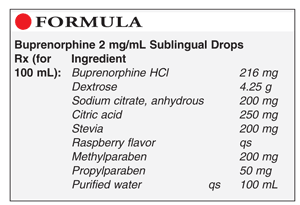US Pharm. 2009;34(2):40-41.

Method of Preparation: Calculate the quantity of each ingredient for the amount to be prepared. Accurately weigh or measure each ingredient. Heat about 75 mL purified water to about 90°C and dissolve the parabens. Cool mixture; add the remaining ingredients and stir until dissolved. Add sufficient purified water to volume and mix well. Package and label.
Use: Buprenorphine sublingual drops are used in the treatment of moderate-to-severe pain.
Packaging: Package in tight, light-resistant dropper containers.
Labeling: Keep out of the reach of children. Use only as directed. Keep tightly closed.
Stability: A beyond-use date of 14 days can be used when preparation is stored in a refrigerator.1
Quality Control: Quality-control assessment can include weight/volume, pH, specific gravity, active drug assay, color, clarity, rheologic properties/pourability, physical observation, and physical stability
(discoloration, foreign materials, gas formation, mold growth).2 The pH of this solution should be 4.0 to 4.8.
Discussion: Sublingual drops may be used in patients who have difficulty swallowing tablets or capsules and in those for whom the parenteral, rectal, and topical routes may not be desired.
Buprenorphine hydrochloride (HCl) (C29H41NO4.HCl, MW 504.10; Buprenex, Subutex) is a synthetic partial opiate agonist analgesic derived from thebaine and structurally related to morphine. It occurs as a white, crystalline powder that is soluble 17 mg/mL in water and 42 mg/mL in alcohol at room temperature. The commercial injection has a pH in the range of 3.5 to 5.5. Regarding potency, 1.08 mg buprenorphine HCl is equivalent to 1.0 mg buprenorphine. It is commercially available as an injection (0.3 mg/mL) and also as sublingual tablets (2 mg, 8 mg).3
Dextrose (MW 180.6, anhydrous; MW 198.17, monohydrate) occurs as odorless, sweet-tasting, colorless crystals or as a white crystalline or granular powder. It is soluble in water (1 g in 1 mL), 95% ethanol (1 in 60), and glycerin. It is a hygroscopic, stable material and should be stored in a cool, dry place.4
Sodium citrate (trisodium citrate, C6H5Na3O7, MW 258.07, anhydrous; dihydrate, MW 294.10) occurs as colorless crystals or as a white, crystalline powder. The hydrous form is freely soluble in water (1 g in 1.5 mL) and very soluble in boiling water (1 g in 0.6 mL); it is insoluble in alcohol.5
Citric acid (citric acid monohydrate, C6H8O7.H2O) occurs as colorless or translucent crystals or as a white, crystalline, efflorescent powder that is odorless and has a strong, tart, acidic taste. One gram is soluble in less than 1 mL water and 1.5 mL ethanol.6
Stevia (honey leaf, yerba dulce) powder is a relatively new sweetening agent made from the leaves of the Stevia rebaudiana Bertoni plant. It is natural, nontoxic, and safe, and it occurs as a white, crystalline, hygroscopic powder. It can be used in both hot and cold preparations.7
Methylparaben (methyl hydroxybenzoate, methyl parahydroxybenzoate, C8H8O3) is available as colorless crystals or as a white, crystalline powder that is odorless or almost odorless and has a slight burning taste. It is an antimicrobial preservative most effective in solutions between pH 4 and 8. One gram is soluble in 400 mL water, 3 mL 95% ethanol, 60 mL glycerin, 200 mL peanut oil, and 5 mL propylene glycol; it is practically insoluble in mineral oil.8
Propylparaben (propyl hydroxybenzoate, propyl parahydroxybenzoate, C10H12O3) is available as a white, crystalline, odorless, and tasteless powder. It is an antimicrobial preservative most effective in solutions between pH 4 and 8. The melting point for propylparaben is 95°C to 98°C. One gram is soluble in 2,500 mL water, 1.1 mL ethanol, 250 mL glycerin, 3,330 mL mineral oil, 70 mL peanut oil, and 3.9 mL propylene glycol.9
REFERENCES
1. US Pharmacopeial Convention, Inc. USP Pharmacists' Pharmacopeia. 2nd ed. Rockville, MD: US Pharmacopeial Convention, Inc; 2008:775-779.
2. Allen LV Jr. Standard operating procedure for performing physical quality assessment of oral and topical liquids. IJPC. 1999;3:146-147.
3. AHFS Drug Information. Bethesda, MD: American Society of Health-System Pharmacists; 2008:2216-2223.
4. Day A. Dextrose. In: Rowe RC, Sheskey PJ, Owen SC, eds. Handbook of Pharmaceutical Excipients.
5. Amidon GE. Sodium citrate dihydrate. In: Rowe RC, Sheskey PJ, Owen SC, eds. Handbook of Pharmaceutical Excipients. 5th ed. Washington, DC: American Pharmaceutical Association; 2006:675-677.
6. Amidon GE. Citric acid. In: Rowe RC, Sheskey PJ, Owen SC, eds. Handbook of Pharmaceutical Excipients. 5th ed. Washington, DC: American Pharmaceutical Association; 2006:185-187.
7. Reynolds JEF, ed. Martindale: The Extra Pharmacopoeia. 30th ed. London, England: Pharmaceutical Press; 1993:1049.
8. Johnson R, Steer R. Methylparaben. In: Rowe RC, Sheskey PJ, Owen SC, eds. Handbook of Pharmaceutical Excipients. 5th ed. Washington, DC: American Pharmaceutical Association; 2006:466-470.
9. Johnson R, Steer R. Propylparaben. In: Rowe RC, Sheskey PJ, Owen SC, eds. Handbook of Pharmaceutical Excipients. 5th ed. Washington, DC: American Pharmaceutical Association; 2006:629-632. 5th ed. Washington, DC: American Pharmaceutical Association; 2006:231-233.





